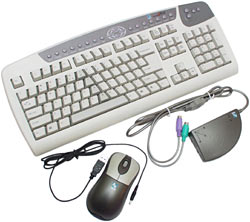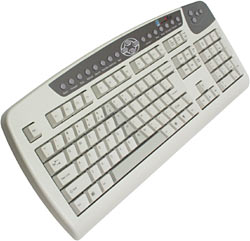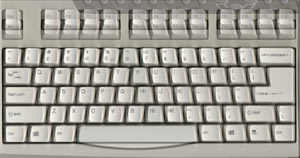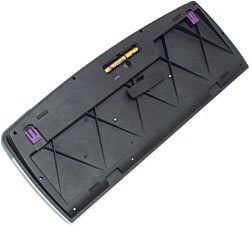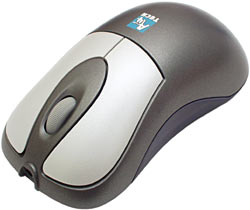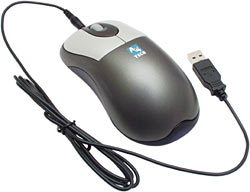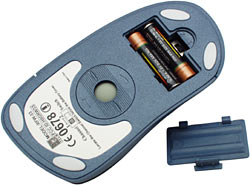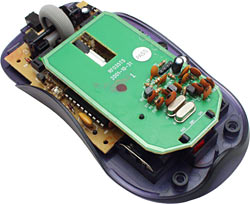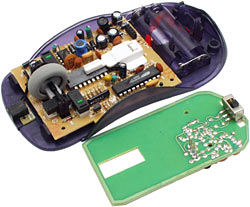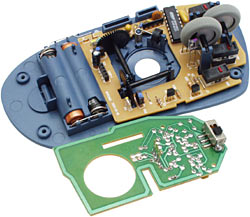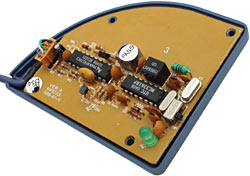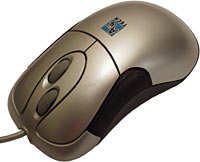
A4 Tech KBS-835RP wireless mouse and keyboard, and RFW-33 wireless mouse
Review date: 16 May 2002.Last modified 03-Dec-2011.
Cordless input devices are handy things, if you need to use a mouse and/or keyboard unusually far from a computer, and an extension cable isn't acceptable. Business presentations, lounge room DVD/MP3/game PCs, servers hiding in cupboards; there are lots of situations where cordless is the way to go.
Or maybe you just hate cables.
The problem with cordless mouses and keyboards, though, is that nobody's managed to make one that runs on crackpot power yet. You need batteries, and the batteries eventually go flat.
In normal use, you'll generally see something like three months of life out of a set of AAA alkalines in a cordless mouse, and twice that or more from a couple of AAs in a keyboard. So it's not as if you're changing batteries daily. But it'd be nice if you didn't have to at all.
A4 Tech have gone some way towards solving this problem, because they're now making rechargeable cordless mouses. They haven't come up with a rechargeable keyboard yet, and most of their cordless gear isn't rechargeable. But they've also got some other features that might tempt you away from the bigger names in cordless gear.
The KBS-835RP
This is A4's current flagship cordless input set. Rechargeable optical mouse, non-rechargeable keyboard, receiver box.
First up - that weird looking keyboard.
The overall layout of this keyboard is quite conventional, but the shape of the keys isn't.
This is, according to A4 Tech, a "TypEEasy Anti-RSI Health Keyboard", alleged to make typing "much easier and faster". They make a variety of wired and wireless versions of it.
The idea is that the angled keys let you hold your hands more naturally, with the wrists straighter than a normal key layout permits. There are explanatory pictures on their page for these keyboards.
Frankly, it beats me how this helps. The actual positions of the keys haven't changed, and the different-shaped key-tops are pretty much just a cosmetic feature, as far as I can see. You can already type with straight-ish wrists on a regular keyboard, if you teach yourself to; ergonomicists have been recommending as much for, approximately, ever. These parallelogram keytops don't change anything that I can see.
Here's a scan of the angled portion of the A4 Tech 'board, overlaid with a scan of the same area of a conventional keyboard (which has a somewhat bulbous space bar, but is otherwise unremarkable).
I lined up the two scans so that the top-left backtick/tilde (` and ~) keys were on top of each other. And that left all of the other keys pretty much perfectly superimposed on each other, too, as you can see. The A4 'board's keys aren't the same shape, but they're in the same spot, and you therefore have to do nothing differently to hit them. That's good, but it leaves me scratching my head about what the advantage of this system's meant to be. It's not as if this is a split keyboard, or anything. It's still basically straight.
On the plus side, the A4 keyboard doesn't make typing any harder.
The keyboard has a soft-touch feel which you may or may not like, but it's got reasonable tactile response and doesn't make a racket. When I was using it, I kept feeling key corners and edges where I didn't expect them to be, but my error rate didn't skyrocket because of that. It's an easy keyboard to get used to.
I can't say I'm crazy about the big-enter-key, backslash-by-right-shift layout of this 'board, but lots of people don't seem to mind such keyboards; the one in the overlay picture above has the same layout. Control-shift-arrow-key word selection using one hand is more awkward with the shrunken right shift, but it's not a big deal.
This keyboard, like a lot of other PC 'boards these days, also has a row of little programmable keys along the top. They don't do much unless you install the included driver software, and they're not terribly useful in a normal desktop computing situation anyway. For couch-based lounge-room computing or business presentation purposes, though, it's nice to have an on-keyboard volume control, and such.
There's a Sleep button on the top button row, which activates the standby mode in current Windows flavours, whether or not you've installed the keyboard software. It's not something you're going to want to press in the middle of a game, or if your computer isn't actually able to wake up from standby mode properly, but it's unlikely to be a serious problem. There is, thankfully, no matching Power button.
The keyboard's two AA alkaline batteries (which are included) go in the usual little bay on the underside. The 'board's got a couple of ordinary flip-up feet, as well, plus a channel switch; both mouse and keyboard can use one of two channels, and can both use the same channel setting at once without interference.
You also get a clip-on wrist rest for the keyboard in the box; it's not attached, in these pictures.
The KBS-835RP mouse doesn't look more innovative than the keyboard, but it is.
It's a cordless all-surface optical unit, and it works in the same way as other modern optical mouses. A red LED lights the surface under the mouse, and a little camera chip takes thousands of pictures of the surface per second, then looks at how the surface seems to be moving, and translates that into mouse movements.
This mouse, though, comes with a couple of nickel metal hydride (NiMH) AAA cells for power, and a USB lead terminating in a barrel plug.
The USB lead isn't for data - plug the mouse into a computer using the lead and the PC won't register a new device. All that's connected is the five volt power line from the USB port, and that power's used to charge the mouse's batteries. It works like a USB phone charger cable, in other words.
While the mouse is charging, a second red LED under a smoked window in the side lights up. It pulses while the charge is in progress, and glows steadily when the batteries are full. If you install the supporting driver software - which you don't have to do - you can see how much battery power the mouse thinks it has left in an on-screen display.
A4 Tech say it should take two and a half hours for a full charge; partial charges are, of course, faster. You can use the mouse while it's plugged into its charge lead, and the lead's a fairly generous 1.6 metres (five feet three inches) long.
In use, the mouse is quite comfortable - testament to its ripped-off-from-Microsoft shape. It's a plain two-button-plus-clickable-wheel design, and works as you'd expect; A4 provide driver software that lets you pop stuff up with wheel-clicks, and so on, but you don't have to install it if you don't want to.
The mouse's wheel is a little stiff, but you might like it that way. The buttons feel fine, the overall shape is OK, and despite its batteries it doesn't weigh a ton. Getting rid of that steel ball really helps.
It also has pleasingly snappy response. Like the earlier A4 Tech cordless mouse I tested, it managed a MouseRate sample rate score of about 90Hz. Not as good as the 125Hz standard rate of most USB mouses, and not improve-able with tweaking software, but still much better than most cordless mouses.
Including Logitech and Microsoft's recent cordless efforts, which when I reviewed them managed something like 50Hz and 35Hz, respectively.
Sample rate doesn't affect how far the mouse pointer moves for a given amount of physical mouse movement at a given mouse speed setting. But it does affect the number of times the pointer will be drawn on the screen on the way, and it can make a big difference to how the mouse feels, in use.
Gamers, image editors and plain old serious PC enthusiasts want high mouse sample rates, for smooth aiming, smooth curve drawing, and just plain smooveness, respectively. For office applications, the difference is much less important, and many people don't perceive much of a difference between a scungy old 33Hz serial mouse and a super-tweaked 200Hz gamers' special. But those of us who're a tad more perceptive prefer something with a higher sample rate.
Unfortunately, though, this mouse doesn't handle fast motion well. It's got an old-style low-sample-rate sensor in it, and it's easy to make the pointer skip backwards if you move the mouse fast, no matter what surface you're using the mouse on.
This problem's no worse than it was with the first generation all-surface optical mouses from the big brands, though; in normal use you're not likely to have difficulties. If you're a gamer who likes to use a low mouse speed for precision and as a result whips the mouse around a lot, though, then this one won't suit you, despite its high sample rate.
This mouse also goes to sleep after two minutes of inactivity, and won't wake up if you move it. You have to press a button.
The fancier Microsoft and Logitech cordless optical mouses keep pulsing their illuminator LED when they're in standby mode, and can tell when they've been moved and wake up seamlessly. Doing that at a decently low current draw requires custom hardware, though, and the A4 Tech mouse clearly ain't got it; it's using something pretty close to a plain old corded-mouse sensor rig, as far as I can see. So you've got to press a button. This applies even when the mouse is plugged into its charge lead, and so doesn't need to save power any more. It does it anyway.
The KBS-835RP receiver connects to your PC with two PS/2 plugs. As far as the computer's concerned, the receiver is just a PS/2 keyboard and mouse, which happen to never do anything if the actual mouse and keyboard aren't powered up and within range.
So you can plug the receiver into a hidden server, if you like, and it'll always boot without complaining about a missing mouse or keyboard.
There's an activity light on the receiver, and also LEDs for Num Lock, Scroll Lock and Caps Lock. The keyboard, like every other cordless model I've seen, saves power by not having any LEDs of its own.
The radio system's useful range depends on your local radio environment, the position and alignment of the receiver and transmitters, and how close the receiver is to your computer. With the receiver a few feet from the computer, mouse control went flaky about 2.5 metres from the receiver. The keyboard was OK up to maybe four or five metres, depending on alignment and intervening objects. Your mileage may vary.
The radio system this kit uses has an "ID code" feature, which lets you use a button on the receiver to bind only one keyboard and mouse to one receiver, regardless of which of the two switch-selectable channels you've chosen for each device. So you should be able to have an office full of these things without interference problems. I didn't have another kit handy to see whether this feature actually worked, though, and it won't work at all if you haven't installed the supporting software.
One thing I did notice is that at one point the mouse pointer became erratic for about one second every time I pressed a key on the keyboard. It still moved in basically the right direction, but it did so slowly and unevenly. Basically, it couldn't be used until that second had elapsed.
This was really annoying. Even for ordinary desktop tasks, it's a pain; normal users commonly want to move the mouse right after pressing a key. For fancier tasks like selecting icons with Control held down (to add them to the existing selection), it's really bad - when a key's held down, the mouse is constantly erratic. For Photoshop work, it's a freakin' nightmare.
And then the problem went away.
I don't know why. I'd been fooling with the ID Connect button and the channel assignment switches constantly, and nothing had helped. Then, a while after making another change that hadn't helped, the thing just came good, and mouse and keyboard worked together in a perfectly acceptable fashion again.
This problem might have had to do with radio interference from something else, I suppose; I'm flummoxed. It didn't recur. Beats me what it was.
I'm not sure what the KBS-835RP costs. Apparently, the A4 distributors here in Australia will have stock of it towards the end of June. The mouse is the same as A4's RFSOP-35, though, and that's $AU93.50 delivered from Aus PC Market.
Aus PC are currently selling the older RFKB-5 mouse and keyboard set, which I review here, for $AU121 delivered. The KBS-835RP shouldn't cost a whole lot more. Maybe only $AU150 delivered, but don't hold me to that.
It certainly ought to be below the $AU220 delivered price of Logitech's Cordless Freedom kit, which I review here, along with Microsoft's underwhelming $AU159.50 Wireless Intellimouse Explorer.
The RFW-33
This mouse-plus-receiver kit is another two-channel, PS/2-plug system, this time with vaguely Logitech-ish styling. It's a normal opto-mechanical (ball) unit, without rechargeable batteries. It needs less power than the KBS-835RP mouse, though, because it's not running high power DSP gear and an illuminator LED; this also means that it doesn't need a button press to wake it up after a couple of minutes. If the batteries aren't flat, this mouse is always ready to go.
Click the picture at the right for a horizontal, 1280-pixel-wide version.
The RFW-33 looks as if it has a side thumb button (for a right-handed person's thumb, anyway), but it doesn't. It's got a side panel that looks like a button and can be pushed in a bit, but there's no switch on the other side of it.
One of the two scroll wheels is clickable, the other one isn't. So this mouse is actually only one wheel up on the normal wheelie-mouse control complement.
You get a couple of AAA alkalines with the mouse. They look like Duracells, but they aren't, in the great tradition of Taiwanese pack-in batteries.
The RFW-33 receiver is simpler than the KBS-835RP one; one channel switch, one activity light, one PS/2 plug cable, and that's it. There's no ID code button; you can only use a couple of these mouses within range of each other.
The RFW-33's range is much the same as that of the KBS-835RP; two to three metres, provided the receiver isn't right next to the computer.
This mouse has the same roughly 90Hz sample rate as the optical A4 Tech, which is good. It's also pretty hard to freak out by moving it too fast, though it's still possible.
The RFW-33 is considerably heavier than the optical mouse, though; it's larger, and the ball's weight is significant too. So I still wouldn't want to use it for twitch games, even when its ball and rollers were new and clean and pristine.
I'm just a wimp who's been spoiled by optical mouses, though. Lots of people don't mind a heavier mouse.
Power consumption
When C'T Magazine tested wireless mouses, the A4 Tech offerings consumed less power than the competition, which is something A4 seem rather happy about; they proudly trumpet the mouse's 6.5 milliamp (mA) average current draw. But that mouse was the RFSW-25, an opto-mechanical model; no optical models were in the C'T comparison.
The back of the KBS-835RP box mentions super low power consumption, but it refers to the RFSW-25 as well. The mouse that comes in the box is quite different, and consumes a lot more power.
This isn't terribly important, of course, because you can just charge the thing as needed. But, nonetheless, while you're moving the KBS-835RP optical mouse around it draws 65 to 70mA, which drops to about 21mA when you stop moving it and the LED dims. If you don't move the mouse again, it'll keep drawing 21mA until the two minute sleep timer cuts in, and then it'll drop to a bit less than 0.1mA.
The NiMH cells that come with the KBS-835RP kit don't have a capacity listed on the outside, but they're unlikely to manage more than about 650mAh. So they've probably got enough juice to power the mouse for around ten hours of continuous movement. Maybe a solid 24 hours of continuous normal computer use.
Of course, that'll do nicely, provided you plug in the charge lead now and then.
The KBS-835RP keyboard draws about 0.3mA when its batteries have been freshly inserted and it's doing nothing. That rises to a little more than 4mA when you're pressing buttons on the keyboard; when you stop, it falls to zero, then creeps back up over a few seconds to 0.3mA again.
After reviewing Logitech's fancy cordless keyboard, I've learned to leave wireless gear alone for a while with power connected, to see if it's doing something weird for the first few minutes, or hours for that matter. I wandered away from the testbench for more than an hour. When I came back, the keyboard's quiescent power draw had dropped to zero. Typing still drew 4.1mA or so.
Even at 0.3mA, this keyboard would take the best part of a year to flatten a set of alkalines if you put batteries in it and then sat it on a shelf. Since its quiescent draw drops to nothing measurable after the batteries have been in it for a little while, its real world standby time will be about the same as the battery shelf life.
If you type non-stop, this keyboard will work for three to four weeks on a set of AA alkalines, depending on battery quality. In normal use, six months could easily be achieved - depending, of course, on how normal you are. So I think A4 can be forgiven for not making the thing rechargeable.
The RFW-33 mouse also lives up to A4's low-drain claims, with a peak frantic-activity draw of around 8mA, and a minimum draw while it's moving of about 5mA. Stop moving it and it draws 1.7mA, but only for a bit more than 20 seconds; then it falls to 0.1mA, and stays there, apparently forever. That's the price you pay for not having to press a button to wake it up.
AAA alkaline cells have a capacity of at least 1000mAh into low loads like this. So you'll get well over a year of standby time out of this mouse, or something like a week of non-stop use. There is, again, no way to say how long the batteries will last for a given user, but it should be a good long while.
Poking around inside
Take the lid off the KBS-835RP mouse and you see plenty of discrete components on the top circuit board. It looks positively, um, classic, compared with the surface-mount, multi-layer-board, super-integrated designs that the bigger names are using in their mouses these days.
Practically, there's not much reason to be worried about a mouse with a forest of discrete components inside, instead of a smaller number of fancier parts. There are more things that can be mis-soldered or otherwise messed up in the manufacturing process when you've got more parts, so the chance of a dead-on-arrival mouse is higher. But if the thing works in the first place, it should keep working perfectly well.
Older-style construction also, of course, means older-style components, in this case at least. That explains the A4 mouse's susceptibility to skipping when you move it quickly, and it also explains the simple two minute sleep timer.
With the top board removed and inverted, you can see the antenna trace around the outside of that board. There's another little cityscape of components around the sensor assembly on the bottom board.
Inside the RFW-33 mouse, the story's much the same. The opto-mechanical sensor assembly takes up more real estate than its optical cousin, but it needs fewer transistors to make it work. The RF side is still composed of a bunch of separate components.
Most of the electronic complexity's on the top board in this mouse, but the extra mechanics on the bottom board make up for it.
Inside the RFW-33 receiver, there's another little electronic township.
This receiver's circuit board also uses an edge-track antenna on the underside. That explains why the receiver's as big as it is. The components don't need that much board, but the antenna does.
Overall
Assuming it's not ferociously expensive, the KBS-835RP is a perfectly all right product. So's the RFSOP-35 mouse, by itself, if you just want a cordless optical pointing device and don't need a keyboard to go with it.
Logitech and Microsoft haven't managed to produce a wireless optical mouse with a decent sample rate yet. I don't know about other manufacturers, but A4 have done it, and made it rechargeable, too. It's still not a fabulous twitch gamers' accessory, thanks to its old style sensor. But it's likely to suit most people just fine.
All the "Anti-RSI Health Keyboard" does is change the shapes of the tops of the keys; as far as I can see, this certainly doesn't justify A4 Tech's numerous claims.
But it doesn't get in your way, either, and it too works perfectly well. Plus, it looks strange and interesting.
The RFW-33 has OK performance, excellent battery life, and probably also a good price - but, again, nobody in Australia seems to have the darned thing yet, so I'm not sure.
Its dummy side button is a bit weird, but it doesn't get in the way. Its two scroll wheels aren't terribly more useful than one wheel, if you ask me, but they both do something even if you haven't installed the driver software (one scrolls fast, one scrolls slow, in Windows), and there's no harm in having them.
Regular readers know that as far as keyboards go, you can have my IBM 42H1292 when you tug it out from under my slumped corpse. And, in the mouse department, the Intellimouse Explorer 3.0 (reviewed here) is my current pointer-pusher of choice.
If you need wireless, though, A4's options are actually pretty good. Check 'em out.
